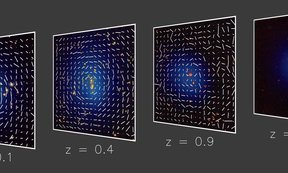The "Spektrum-Röntgen-Gamma" satellite was launched in July 2019. On board: the extended ROentgen Survey with an Imaging Telescope Array, eRosita for short, a space telescope developed by the Max Planck Institute for Extraterrestrial Physics (MPE). Over the past few years, the telescope has produced X-ray images of the entire sky with an unprecedented resolution. Around 12,000 galaxy clusters have been found using the X-ray images. This data enables cosmological models to be tested and dark matter and energy to be researched.
Galaxy clusters consist of up to thousands of galaxies and are the largest gravitationally bound structures in the Universe. In order to draw conclusions about the composition of the Universe from the new data, the mass of these objects had to be estimated. This was the task of Tim Schrabback's working group at the Institute of Astro- and Particle Physics at the University of Innsbruck. Schrabback's group deals with the gravitational lensing effect, which describes the distortion of light by large masses and can be used to calculate the mass of very distant objects. Sebastian Grandis, Senior Scientist in the group, explains how this works:
Distorted background galaxies
"We knew from previous studies that these galaxy clusters must exist," says Grandis. "With eRosita, we specifically searched for and found them. The crucial factor here is that the plasma in the galaxy clusters emits X-rays because the temperatures there are incredibly high - around 10 million °C. Initially, we only know the luminosity of these objects and their distance to us, which is several billion light years. This is where the gravitational lensing effect comes into play. We analyze the shapes of galaxies that are located behind the galaxy clusters. These appear distorted because the light from the background galaxies has been deflected by the gravity of the clusters on its way to us. Using Einstein's theory of General Relativity, we can then estimate the mass that has caused this distortion. The more mass, the stronger the distortion."
The calculated masses of the galaxy clusters with the most reliable data were sent back to the MPE, where they were compared with cosmological models to draw conclusions about the formation, composition and expansion of the universe.
Einstein was not wrong
The results of eRosita confirm with high accuracy the result of previous calculations, namely that the universe consists of 29% matter. Most of this is dark matter, about which much remains unknown to this day. The remaining 71% is also a mysterious component: dark energy, first introduced into cosmological models as a "cosmological constant" by Albert Einstein himself. The eRosita results can be used to determine the parameter "w". It’s measured value matches the cosmological constant very precisely. Einstein rejected his hypothesis during his lifetime, but "our calculations show that Einstein was right after all and that it was a mistake for him to reject the cosmological constant later," says Grandis. Understanding the nature of dark energy is one of the greatest challenges in physics today.
The measurement of the largest structures in the universe also contains information about the smallest particles. Neutrinos are electrically neutral and so small that they are almost impossible to detect. In particular, it is currently still unclear what mass neutrinos have. This could soon change thanks to the eRosita data. "The frequency of galaxy clusters at a given mass and distance also allows conclusions to be drawn about the mass of neutrinos, that fly freely through the cosmos and thus have an influence on its development and structure. In combination with other observational methods, our analysis makes it possible to derive the most accurate results currently available for the possible mass range of neutrinos," says Grandis.
International cooperation opens up the cosmos
In order to achieve the greatest possible success with a project like eROSITA, interdisciplinary and international scientific cooperation played a major role. To calculate the gravitational lensing effect, Grandis used data from the Dark Energy Survey, an international research project that observes the universe from the Cerro Tololo Inter-American Observatory in the Atacama Desert in Chile. In addition, the eRosita collaboration used gravitational lensing data from two other observing programs, the Hyper Suprime-Cam Strategic Survey taken by the Subaru Telescope in Hawaii, and the Kilo Degree Survey (KiDS) taken by the European Southern Observatory's VLT Survey Telescope. "An important validation step of our analysis was that all three observing programs provide consistent measurement results for the eRosita galaxy clusters," adds Florian Kleinebreil, who led the KiDS analysis of eRosita galaxy clusters as a PhD student at the Institute of Astro- and Particle Physics.
But there have also been significant setbacks: The SRG satellite on which the eRosita telescope is mounted is a Russian-German scientific mission. Cooperation with the Russian space agency Roskosmos was halted in February 2022 and eRosita was put into safe mode. Since then, it has not resumed scientific operations, which is why data could only be collected until 2022.
Two weeks ago, the eRosita consortium published the largest data catalog of high-energy cosmic sources to date and made it available to the scientific community, as the Max Planck Institute for Extraterrestrial Physics announced in a press release. The catalog includes more than 900,000 X-ray sources in the universe, from about 710,000 supermassive black holes in distant galaxies (active galactic nuclei) to 180,000 active stars in our own Milky Way to 12,000 galaxy clusters and a small number of other exotic sources such as X-ray emitting binary stars, supernova remnants, pulsars and other objects.
Publications:
The SRG/eROSITA All-Sky Survey: Dark Energy Survey Year 3 Weak Gravitational Lensing by eRASS1 selected Galaxy Clusters
The SRG/eROSITA All-Sky Survey: Weak-Lensing of eRASS1 Galaxy Clusters in KiDS-1000 and Consistency Checks with DES Y3 & HSC-Y3
The SRG/eROSITA All-Sky Survey: Cosmology Constraints from Cluster Abundances in the Western Galactic Hemisphere

